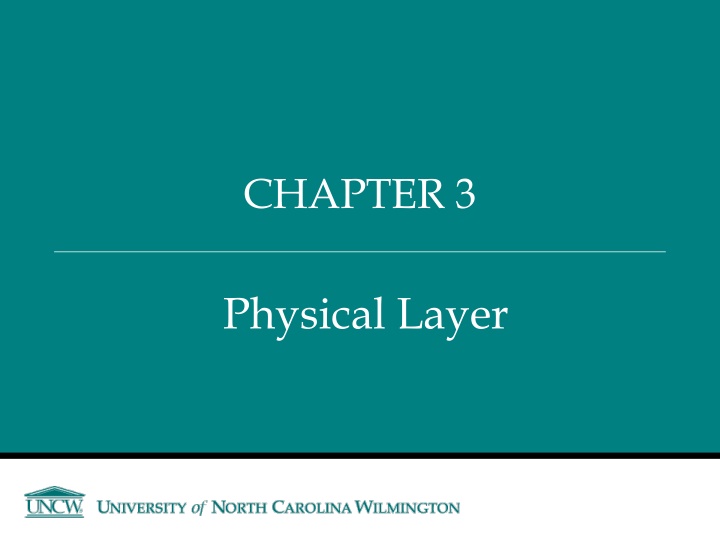
Physical Layer in Computer Networks
Explore the Physical Layer in computer networks, covering circuit configurations, data flow and transmission types like simplex, half-duplex, and full-duplex. Learn about multiplexing techniques such as Frequency Division Multiplexing (FDM) and more to enhance your knowledge of network hardware and circuits.
Download Presentation

Please find below an Image/Link to download the presentation.
The content on the website is provided AS IS for your information and personal use only. It may not be sold, licensed, or shared on other websites without obtaining consent from the author. If you encounter any issues during the download, it is possible that the publisher has removed the file from their server.
You are allowed to download the files provided on this website for personal or commercial use, subject to the condition that they are used lawfully. All files are the property of their respective owners.
The content on the website is provided AS IS for your information and personal use only. It may not be sold, licensed, or shared on other websites without obtaining consent from the author.
E N D
Presentation Transcript
CHAPTER 3 Physical Layer
Outline Recap 2. Application Layer 2.1 Hardware 2.2 Application Architecture (Software) 2.3 Web 2.4 Email Outline 3. 3.1 Circuits 3.2 Media 3.3 Digital Transmission (Digital Data) 3.4 Analog Transmission (Digital Data) 3.5 Digital Transmission (Analog Data) Physical Layer 2
Network Layers Computer 1 Computer 2 3
Acronyms FDM Frequency Division Multiplexing TDM Time Division Multiplexing 4
3 Physical Layer - Overview Network Layer Includes network hardware and circuits Data Link Layer Physical Layer Types of Circuits Physical circuits connect devices & include actual wires Logical circuits refer to the transmission characteristics of the circuit Physical and logical circuits may be the same or different. For example, in multiplexing, one physical wire may carry several logical circuits. 5
3.1.2 Circuit Configurations Basic physical layout of the circuit Configuration types: Point-to-Point Configuration Multipoint Configuration 6
3.1.2 Data Flow (Transmission) How does data flow through the circuit Configuration types: Simplex Half-Duplex Full-Duplex 9
3.1.3 Data Flow (Transmission) Multiplexing Combines many low speed circuits into one high speed transmission Categories of multiplexing 11
3.1.3 Frequency Division Multiplexing Makes a number of smaller channels from a larger frequency band by dividing the circuit horizontally FDM FDM Host computer circuit Four terminals 12
3.1.3 Time Division Multiplexing Dividing the circuit vertically TDM allows terminals to send data by taking turns 13
3.1.4 Inverse Multiplexing Combines a number of low speed circuits to create a single high speed circuit on the opposite ends Why would companies choose to do this? 14
Inverse Multiplexing (IMUX) Shares the load by sending data over two or more lines 15
Digital Subscriber Line (DSL) Became popular as a way to increase data rates in the local loop. 16
3.2 Media Physical matter that carries the transmission Types: Guided Media Radiated (Unguided) Media 17
3.2.1.1 Guided: Twisted Pair (TP) Wires Commonly used for telephones and LANs Reduced electromagnetic interference TP cables have a number of pairs of wires Price: Speed: Distance: Common Use: 18
3.2.1.2 Guided: Coaxial Cable Less prone to interference than TP due to shield More expensive than TP, thus quickly disappearing Price: Speed: Distance: Common Use: 21
3.2.1.3 Guided: Fiber Optic Cable Light created by an LED (light-emitting diode) or laser is sent down a thin glass or plastic fiber Has extremely high capacity, ideal for broadband Works well under harsh environments Price: Speed: Distance: Common Use: 23
3.2.1.3 Guided: Fiber Optic Cable Fiber optic cable structure (from center): Core (v. small, 5-50 microns, ~ the size of a single hair) Cladding, which reflects the signal Protective outer jacket How they are made: http://www.youtube.com/watch?v=llI8Mf_faVo Communication: http://www.ehow.com/video_4951202_optical-fiber-work_.html 24
Types of Optical Fiber Multimode (about 50 micron core) Earliest fiber-optic systems Signal spreads out over short distances (up to ~500m) Inexpensive Graded index multimode Reduces the spreading problem by changing the refractive properties of the fiber to refocus the signal Can be used over distances of up to about 1000 meters Single mode (about 5 micron core) Transmits a single direct beam through the cable Signal can be sent over many miles without spreading Expensive (requires lasers; difficult to manufacture) 25
3.2.1.3 Guided: Which is faster Fiber or Copper? Fiber transmits via light does that mean it is faster than copper b/c it travels at the speed of light? Data Carrying Capacity What should companies use? 3 - 27
3.2.2.1 Wireless (Unguided) WLAN (Radio) Wireless transmission of electrical waves through air Each device has a radio transceiver with a specific frequency Includes Speed: Distance 28
3.2.2.2 Wireless Media - Microwave High frequency form of radio communications Performs same functions as cables Speed: Distance: 29
3.2.2.3 Wireless Media - Satellite Special form of microwave communications Signals travel at speed of light, yet long propagation delay due to great distance between ground station and satellite Speed: Distance: 30
3.2 Factors Used in Media Selection Type of network Cost Transmission distance Security Error rates Transmission speeds 31
